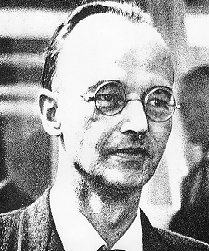Although he received a far more lenient sentence than the Rosenbergs, Klaus Fuchs provided information to the Soviets which was of considerably greater significance.
Emil Julius Klaus Fuchs was born in Germany in 1911. As a young man, he was interested in politics and became a member of the German Communist Party. As the Nazi's power grew in Germany, the Gestapo began rounding up Communists, forcing Fuchs to leave his country or be imprisoned. Fleeing through France, Klaus Fuchs made his way to England, where he resettled. As a German refugee, Klaus Fuchs received some aid in England, including a scholarship to Bristol University. By 1937, Fuchs had graduated from Bristol with a doctorate in Physics. He decided to continue his education with advanced studies in Physics at Edinburgh University.
By 1940, the war in Europe had escalated and Britain began to fear for its national security. All Germans in England were taken into custody and placed into internment camps, where they were to be held until the end of the war. Klaus Fuchs was taken to a camp located in Quebec, Canada where he would live for several months. A prominent faculty member at Edinburgh University, Professor Max Born, intervened on Fuchs behalf and was able to obtain special treatment for Fuchs. By the spring of 1941, Fuchs was once again engaged in his studies at the University. Within months, Fuchs would be asked to work on the British "Tube Alloys" program in Birmingham, the British atomic bomb research project.
In 1943, Fuchs was transferred to the Columbia University in New York City where he began to work on the Manhattan Project, the American atomic bomb program. Klaus Fuch's work with the Americans eventually took him to the Los Alamos, New Mexico research facility, where Klaus Fuchs was regarded as an excellent scientist and researcher, a serious man who focused with great intensity on his work. No one suspected that Fuchs had been transferring very detailed notes on the bomb project to a Soviet courier named "Raymond", who was actually Harry Gold.
By 1948, the Venona cables were beginning to be deciphered. One of these cables was a report on the progress of the atomic bomb research written by Fuchs himself. It was not evident at first whether Fuchs had written the report for the Soviets or if it had been acquired by the Soviet's through some other means. Either way, it was proof that the Russians had penetrated the secrecy of the Manhattan Project. By January 1949 suspicion of Fuch's involvement in espionage had grown. The FBI confronted him with accusations of spy activity at the Harwell Atomic Research facility in England, where Fuchs was the head of the theoretical division. Fuchs soon confessed to his part in the theft of atomic secrets. On March 1, 1950, Fuchs was found guilty of communicating information to the Soviets concerning atomic research. He was sentenced to fourteen years in prison. After serving nine years of his sentence, Fuchs was released. He illegally relocated in East Germany, where he was granted citizenship and resumed his scientific career and lectured in Physics.

